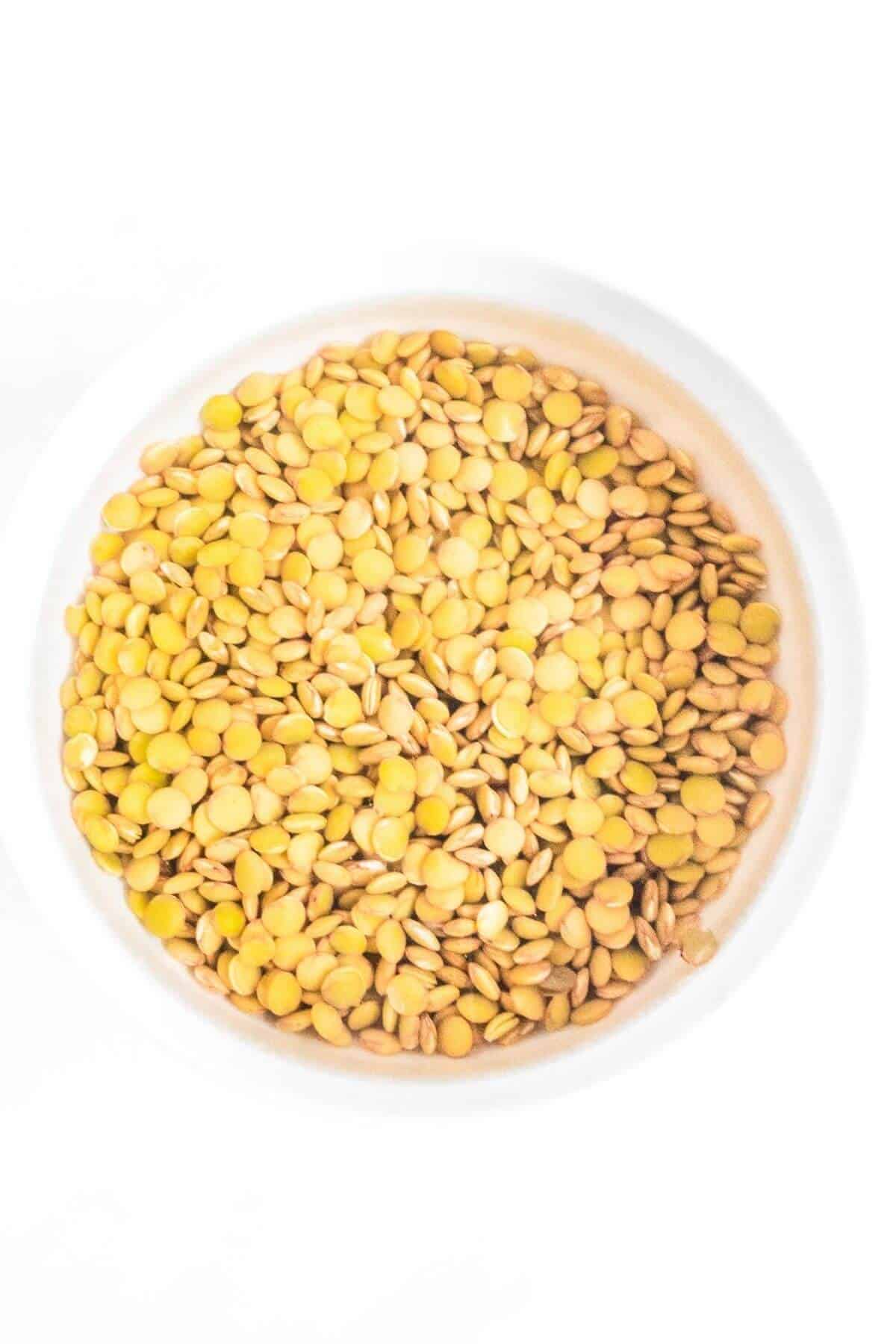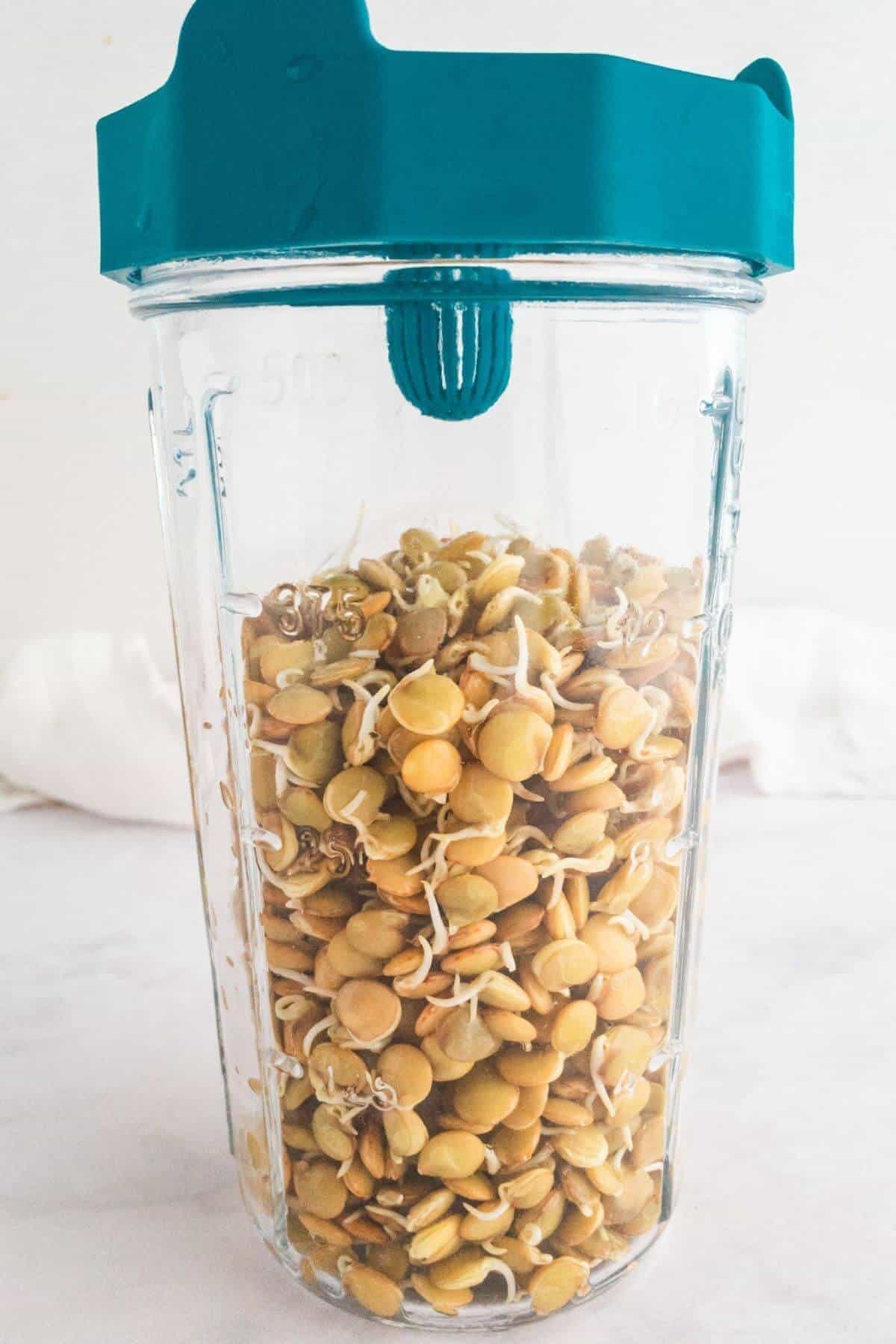How to sprout lentils at home in 3 easy steps and liven up your meals. Sprouted lentils are really versatile and can be eaten raw, added to salads, soups, curries, wraps, vegan meatballs and more.

With a little patience and 2-3 days you can be sprouting lentils indoors with no special equipment.
In fact I like sprouting lentils with just a bowl, a fine mesh sieve and with fresh cool water for rinsing and draining.
This is all you need to get started once you have those lentils in hand. I use ½ cup / 100g of lentils at a time. Feel free to change the amount to suit your own preference.
Sprouting Series
If you love the idea of sprouting your own food you may like to check out the other articles in my sprouting series, such as: How to grow broccoli sprouts, How to sprout lentils, How to sprout chickpeas, sprouting quinoa, sprouting adzuki beans and sprouting buckwheat groats.
Jump to:
- Sprouting Series
- Step 1 - Soak first.
- Step 2 - Rinse and drain.
- Step 3 - Allow them to sprout.
- How to store.
- FAQ's
- Is it safe to sprout lentils?
- How long does it take to sprout lentils?
- Do you rinse them with warm or cold water?
- How to tell if lentil sprouts have gone bad.
- Are sprouted lentils good for you?
- Which lentils sprout?
- Other sprout recipes you may like:
- How to sprout lentils in a jar.
- 📖 Recipe
- Food safety
- 💬 Comments

Step 1 - Soak first.
Be sure to use dried lentils produced specifically for sprouting, for best results.

Give the lentils a good rinse to wake them up, add them to a bowl and top them with at least a couple of inches of fresh cold water.
I typically sprout lentils starting with ½ cup (about 100g) at a time on the countertop, and I leave them to soak for 8-12 hours. They will more than double in size during this time.
I leave them overnight for this part as it's easy, and I don't really have to think about it.
You can lightly cover them with a piece of kitchen towel to keep any fruit flies away. I do that sometimes in summer.
Step 2 - Rinse and drain.
The next step is to rinse lentils thoroughly and then drain them with fresh cold water.
For this, use a fine sieve held over the sink. It's quick and easy. Give them a shake to aerate them, pick out any odd-looking bits, anything off-colour or that you’re unsure about, and discard them.

Now return the sieve, placing it over the bowl so any excess water will drain off the lentils into the bowl. I like to spread the lentils out so that air can get around them.
Step 3 - Allow them to sprout.
They're all set up now to begin the sprouting lentils process. Soaking loosens the seeds outer coating and wakes them up so that they can start to grow!
Be sure to rinse and drain them twice each day (morning and evening), more often if the weather is hot.
A little shoot will start to emerge from the lentils, usually on day 2. Give them a final rinse and drain when they're about 1cm long or so, typically on day 3.
This is when I like to use them.

Shake the little beauties up in the sieve and take out any that have not sprouted, any that look discoloured. They should look and smell fresh and have a light crunch to them.
How to store.
Grab yourself a large plate and a clean kitchen towel or piece of paper towel, and lay the lentil sprouts out over the plate in one single layer.
Pat them dry gently with a paper towel, then transfer any sprouted lentils that you aren't using straight away into a suitable container with a lid.
I place a piece of kitchen paper into the bottom of the container first. Warmth and moisture are not our friends when lentil sprouts are concerned. Keep them fresh in the fridge for up to 3 days. After that time, discard any that are left.
FAQ's
Is it safe to sprout lentils?
It's safe to sprout lentils at home when appropriately done. However, like any food, they can and will go bad if you're not careful.
Bacteria from our environments are opportunistic. Excess water, warmth or heat can spoil your lentil sprouts and make them unsuitable for eating. So you must do these 3 things:
- use clean equipment
- check them regularly
- rinse and drain them thoroughly 2-3 times per day.
I also pay attention to the Food Standards Agency (FSA) recommendation to only keep sprouts for 2-3 days.
I love eating sprouted lentils when they're at their freshest. This is what I find works best for me, and I haven't experienced any problems doing it this way.
How long does it take to sprout lentils?
From soaking, sprouting lentils typically takes about 2-3 days. I leave mine on the worktop close to the sink so I can keep an eye on them. It’s somewhere cool, temperature wise. You’ll want to avoid putting them near a source of heat so they stay fresh and don’t spoil.
They don’t need to be by a window unless you decide to grow microgreens and you’re looking for an easy light source for photosynthesis.
Do you rinse them with warm or cold water?
I always rinse with fresh cool water. However, I notice that some people use warm water to rinse their lentils. As these lentil sprouts are intended for eating raw I would not using warm water for rinsing, as this may make the lentils more prone to harmful bacteria. So definitely use cool or cold water instead.
If you're at all concerned about the quality of the tap water in your area, you can use cool filtered water or bottled spring water for rinsing.
How to tell if lentil sprouts have gone bad.
They will smell very unpleasant. Their colour may change to a dull deeper colour than fresh lentil sprouts, and they may look and feel a little slimy or sticky. The best thing to do if you notice any of these changes is not to eat them and discard them straight away.
Are sprouted lentils good for you?
According to data from MyFoodData.com (source) , the nutritional benefits of sprouted raw lentils show they're packed with nutrients including protein, vitamin c, iron, and phosphorus.
Which lentils sprout?
Be sure to only eat lentils once they've been previously cooked or sprouted first.
Use whole lentils, organic if possible. Split lentils won't sprout.
Yes, whole lentils from the store locally should sprout (I’ve done this myself and they turned out fine).
Please bear in mind that these will have been produced for cooking, as most people buying lentils will be cooking them, not sprouting lentils and eating them raw.
I look specifically for sprouting seeds from a reputable company. Seeds that are produced for sprouting are done so with stricter safety standards, and have a higher germination success rate than regular off the shelf varieties.
I’ve only played with green lentils to date myself but, you can buy organic whole red and black lentils from sprouting stores online.
Check with the retailer or producer if you’re unsure.
Other sprout recipes you may like:

How to sprout lentils in a jar.
Mason jar method. Using a wide-mouthed mason jar for sprouting lentils will make it easier to remove the lentil sprouts when they're ready when compared to using a regular jar. Find one with a mesh sprouting lid. Holes in the cap allow for easier rinsing and draining and for air circulation.
- Pour ½ a cup of lentils into the jar and top with plenty of cool water. Leave them to soak for 8-12 hours.
- Give them a good rinse and drain over the sink and place the jar upside down over a bowl or at an angle on your draining board to allow any excess water to escape. This is to avoid the lentils sitting in water which will make them rot.
- Be sure to rinse and drain lentils 2-3 times each day until they germinate and start to grow a shoot. I like to mine when they're about a centimetre long. You can leave them a little longer if you wish to.

Regular jar method. Yes, you can use a standard jar, too, for sprouting lentils. Make sure it’s a large jar so you can cover the lentils with plenty of water and there’s room enough for them to grow. They will at least double in size.
For the lid, you can make one by using a piece of muslin/ cheesecloth secured with a rubber band. Use the same steps as above.
📖 Recipe

How to Sprout Lentils (3 easy steps)
Equipment
- Wide mouthed mason jar
- Piece of cheesecloth and rubber band or a sprouting lid
- Strainer or sieve.
- Bowl.
Ingredients
- 100 g (½ cup) Raw green lentils
- fresh cool water as needed
Instructions
- Soak. Give the lentils a good rinse to wake them up, add them to a bowl and top them with at least a couple of inches of fresh cold water. Leave to soak for 8-12 hours or overnight.100 g (½ cup) Raw green lentils, fresh cool water as needed
- Rinse and Drain. The next step is to rinse lentils thoroughly and then drain them with fresh cold water. For this, use a fine sieve held over the sink. It's quick and easy. Give them a shake to aerate them, pick out any grit, odd-looking bits, anything off-colour or that you’re unsure about, and discard. Rinse and drain the lentils every 8-12 hours each day (morning and evening work well).fresh cool water as needed
- Sprout. Return the lentils to the sieve, placing them over a bowl so any excess water will drain off. I like to spread the lentils out so that air can get around them. Alternatively, place them into you mason jar and attach the lid. Leave to one side out of direct sunlight to sprout, making sure to rinse and drain them ever 8-12 hours to keep them fresh. Your lentil sprouts will be ready in 2-3 days when they have germinated and the shoots are about a centremeter long or more. Give them a final rinse, drain and leave to roughly dry on a piece of paper towel before using.fresh cool water as needed
Notes
Tip:
If you're sprouting lentils with a strainer rather than a jar, lightly place a piece of paper towel over the top to help them to stay clean.Storing:
Give the sprouts a final rinse and drain them before storing in a lidded container in the fridge. Place a piece of kitchen paper in the container to draw up any excess water and help to keep the sprouted mung beans crunchy and fresh.Before using:
Check the sprouts before using and freshen them with a quick rinse and drain before adding them to your dishes. Can also be enjoyed as a snack.How to tell if sprouts have gone bad
Food safety
The UK Food Standards Agency recommends people in vulnerable groups always cook any sprouts until steaming hot all the way through before eating them.
This is because sprouts sometimes contain bacteria, which some people may be susceptible to. Vulnerable groups include the elderly, young children, those with a weakened immune system, and pregnant women.
Never eat sprouts or microgreens that look or smell bad or weird. If you're unsure, then throw them out and start again.
Not all seeds or beans are suitable for sprouting or eating raw. Please be sure to check first.
Check the FSA website for more details.






















Comments
No Comments